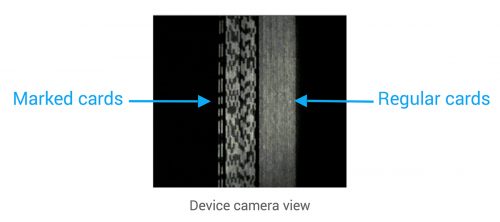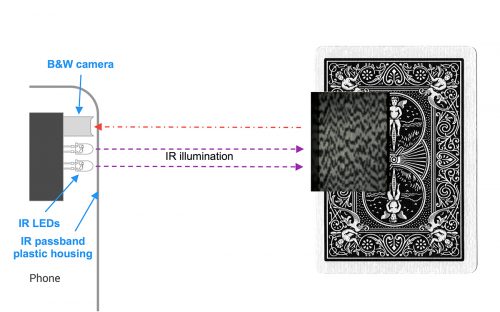Welcome to Purple Pawn, covering games played around the world by billions of people every day.
Smartphone Cheating Device Can Read a Full Deck of Cards
28 Oct
Posted by David Miller as Card Games
At the recent DEFCON hackers conference, members of Google’s anti-fraud and abuse team presented the results of an investigation in to a smartphone-like device for cheating at card games such as Poker. The instrument, which they purchased from a Chinese seller for $1,300, can read through an entire deck of shuffled and stacked cards, telling its user exactly which suit and number will be drawn next. If the user selects options for the number of players and the game being played, the device will even accurately predict who has the winning hand.
The feat is accomplished with a marked deck of cards, infrared LEDs, and a black-and-white camera. The whole process is quite discreet. The cards are marked along the edges with IR ink invisible to the naked eye. The LEDs work through the device’s outer casing, such that their lights are hardly noticeable. And the camera is placed in order to read the card deck from a position laying down across the table.


In fact, a sealed-in-shrink-wrap deck of cards of the purchaser’s choice of brands is included in the package.

The device too is well disguised. It not only looks very much like a Samsung smartphone, it’s built on the Android operating system and will make calls and run standard apps.

In terms of getting the scan results, users have the option to receive audio signals via miniature earpiece (included), coded signals via a vibrating receiver that can be strapped to an arm or leg (also included), or the device can make subtle changes to the time it displays on-screen.
And just in case a smartphone on the table might arouse suspicion, the package also comes with an alternate Bluetooth-connected camera hidden in a car key fob (customizable with different car maker logos).
No Comments
Sorry, the comment form is closed at this time.
Trending
- Massdrop.com
- Oh the Irony—Illuminati Card Game Continues to Inspire Conspiracy Theorists
- Home
- Footprints, an Educational Ecology Game
- USPS Adds Board Game Flat Rate Box
- Baila, the Estonian Drinking Card Game
- Crystal Caste Wins Dice Patent Suit Against Hasbro
- Mirror Game, Red and Blue
- Are Board Games Dangerous?
- The Truth About Dominoes On Sunday in Alabama
Archives
Most Popular Articles
- Oh the Irony—Illuminati Card Game Continues to Inspire Conspiracy Theorists
- The 20 Most Valuable Vintage Board Games
- The Truth About Dominoes On Sunday in Alabama
- Sequence Game, and Variants
- USPS Adds Board Game Flat Rate Box
- Baila, the Estonian Drinking Card Game
- The 13 Most Popular Dice Games
- Are Board Games Dangerous?
- Guess Who? The Naked Version
- What Happened to the Jewel Royale Chess Set?
Recent Posts
- Toy Fair 2019—Breaking Games
- Talisman Kingdom Hearts Edition
- Toy Fair 2019—Winning Moves
- Toy Fair 2019—Games Workshop
- Toy Fair 2019—Star Wars Lightsaber Academy
- Toy Fair 2019—Stranger Things Games
- Toy Fair 2019—HABA
- Licensing Roundup
- Game Bandit
- 2018 A Difficult Year For Hasbro But Not For D&D Or MtG
Recent Comments
- on Toy Fair 2019—Winning Moves
- on Game Bandit
- on Second Look—Dungeons & Dragons Waterdeep Dragon Heist
- on Crowdfunding Highlights
- on Beyblade SlingShock
- on Game Bandit
- on Game Bandit
- on Watch This Game!, the Board Game Review Board Game
- on Second Look—Vampire: The Masquerade 5th Edition
- on Palladium Books Loses Robotech IP License, Cancels Five-Year-Overdue Robotech RPG Tactics Kickstarter





